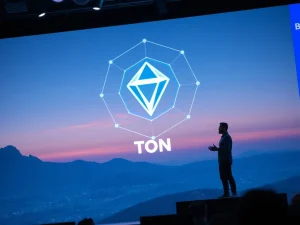Unveiling Grok 3 for Crypto Trading Automation: Genius or Gamble?

The crypto market never sleeps, and neither do the opportunities for profit… or loss. Keeping pace with its relentless volatility can feel like a Herculean task, even for seasoned traders. That’s why the allure of automation, especially powered by cutting-edge artificial intelligence like Grok 3, is incredibly strong. Imagine an AI that could analyze market data, spot hidden patterns, and execute trades faster and more efficiently than any human. Sounds like a dream, right? Elon Musk’s xAI developed Grok 3 as a powerful language model, not specifically for trading, but its data analysis prowess has sparked significant interest within the crypto community. Can Grok 3 truly revolutionize crypto trading through automation? This article dives deep into the reality of using Grok 3 to automate crypto trades, revealing both the exciting potential and the critical challenges you need to know.
Why Consider Grok 3 for Crypto Trading Automation?
Traditional trading bots operate on pre-set rules, which can be limiting in the dynamic crypto sphere. Grok 3 offers a different approach. Its ability to process vast amounts of information and learn from evolving market conditions makes it an intriguing tool for traders seeking an edge. Here’s why many are exploring AI trading with Grok 3:
- Sentiment Analysis Prowess: Crypto markets are swayed by emotions. Grok 3 can analyze social media, news, and online communities to gauge market sentiment, a crucial indicator of potential price swings.
- Pattern Recognition: Grok 3’s machine learning excels at identifying subtle correlations and patterns in data that humans or rule-based bots might miss. This could uncover hidden trading opportunities.
- Flexible Strategy Design: Instead of rigid coding, Grok 3 allows traders to define complex strategies using natural language prompts. This opens doors for more nuanced and adaptable crypto trading bot development.
Grok 3 in Action: Automating Your Crypto Strategy
It’s important to understand that Grok 3 isn’t a plug-and-play crypto trading bot. It doesn’t directly connect to exchanges and execute trades on its own. Think of it as a powerful AI assistant that empowers you to build smarter automation systems. Here’s how traders are leveraging Grok 3 to streamline their crypto strategies:
Code Generation for Trading Logic
Instead of painstakingly writing code from scratch, traders are using Grok 3 to generate code snippets for their bots. For instance, you can prompt Grok 3 to create buy/sell logic with specific parameters like slippage tolerance, take-profit levels, and gas fees. Grok 3 can then generate scripts ready to be integrated into DeFi platforms or expanded using APIs from exchanges like Uniswap or 0x.
Building End-to-End Trading Bots
Some users are pushing Grok 3 further, utilizing it to construct complete, customized bots tailored to specific tokens or trading strategies. Imagine an automated system crafted with Grok 3 that constantly monitors price action and triggers trades based on intricate, user-defined conditions.
Portfolio Rebalancing and Simulation
Beyond simple buy/sell orders, Grok 3 can also generate scripts for portfolio rebalancing. It can even simulate how your positions might perform under varying market volatility scenarios, providing valuable insights for risk management.
Example: Grok 3 Prompt for a Solana High-Frequency Trading Bot
Let’s look at a practical example. A user prompted Grok 3 to outline a high-frequency trading bot framework for Solana (SOL). Here’s a glimpse of Grok 3’s structured response:
Prompt: High-frequency trading bot framework for Solana (SOL)
Grok 3’s Response (Outline):
- Core Configuration: Defines global settings like Solana network endpoint, wallet configuration, trading pair (SOL/USDC), timeframe (one-minute), trade size, risk parameters, etc.
- Data Acquisition Module: Fetches real-time SOL price data using WebSocket connection to Solana or exchange APIs.
- Volatility Analysis Module: Assesses price volatility to adjust trade decisions.
- Trade Signal Generator: Generates buy/sell signals based on price fluctuations and volatility analysis.
- Risk Management Module: Enforces risk controls like stop-loss, position limits, and profit/loss tracking.
- Trade Execution Module: Executes trades on Solana DEXs or centralized exchanges.
- Performance Monitoring Module: Tracks bot performance in real-time, logging trades and calculating metrics.
- Main Control Loop: Orchestrates bot operations in a continuous cycle.
- Shutdown and Cleanup: Safely terminates the bot and finalizes operations.
Disclaimer: This is a framework outline, not functional code. It highlights Grok 3’s ability to structure complex systems based on user prompts. Customization and implementation are crucial for real-world application.
Setting Up Grok 3 for Crypto Trading: A Step-by-Step Guide
Implementing Grok 3 for trading automation requires a more hands-on approach than using pre-built bots. Here’s a practical guide to get you started:
Step 1: Choose a Compatible Trading Platform
Since Grok 3 doesn’t directly interface with exchanges, you’ll need a platform with robust API support. Consider platforms like:
- 3Commas: Known for automated strategy execution.
- TradingView: Excellent for signal generation using Pine Script.
- CryptoHopper: Offers custom strategy building with API integration.
Ensure your chosen platform offers the necessary API functionalities for trade execution and risk management.
Step 2: Integrate Grok 3 with Your Platform
This step involves bridging the gap between Grok 3’s insights and your trading platform. Options include:
- API Automation Tools: Platforms like Zapier or Make.com can connect Grok 3’s analysis to trading platforms for automated actions.
- Custom Python Scripts: For technically inclined users, Python scripts can process Grok 3’s outputs and execute trades via platform APIs.
- No-Code Automation: Tools like IFTTT can trigger basic trading actions based on Grok 3’s sentiment analysis, offering simpler automation possibilities.
Step 3: Define Your Trading Strategies with Grok 3
The effectiveness of Grok 3 hinges on well-defined strategies. Go beyond basic technical indicators and consider incorporating:
- Technical Indicators: RSI, MACD, Bollinger Bands, etc.
- Sentiment Analysis: Leverage Grok 3’s sentiment analysis of social media, news, and influencer opinions.
- On-Chain Data: Incorporate data like whale activity and exchange flows for a holistic view.
Step 4: Backtest Rigorously
Before deploying any strategy live, backtesting is paramount. Use tools like TradingView or CryptoQuant to assess:
- Signal Accuracy: Determine the profitability of Grok 3’s trade signals.
- False Signal Rate: Identify how often Grok 3 generates inaccurate signals, especially in volatile or sideways markets.
- Refinement Opportunities: Fine-tune your strategy parameters based on backtesting results.
Step 5: Implement Robust Risk Management
Crypto markets are inherently risky. Implement risk controls to protect your capital:
- Stop-Loss Orders: Automatically exit losing trades at pre-defined price levels.
- Position Limits: Restrict trade sizes to control exposure.
- Trailing Stops: Secure profits while limiting downside risk during uptrends.
Step 6: Monitor and Refine Continuously
Grok 3’s adaptive nature requires ongoing monitoring and adjustments. Regularly review:
- Performance Data: Track win rates, profit margins, and signal accuracy to assess strategy effectiveness.
- Market Conditions: Adapt your strategy to changing market dynamics, regulatory shifts, or macroeconomic events.
- Prompt Optimization: Revisit and refine your Grok 3 prompts to improve strategy outcomes over time.
The Limitations: Navigating Grok 3’s Challenges
While Grok 3 presents exciting possibilities for automate crypto trades, it’s crucial to be aware of its limitations:
- Data Loss Issues: Reports indicate Grok 3 can experience data loss, miscounting, and inaccurate time references. This can lead to flawed signal detection and poor execution in fast-paced markets.
- No Direct Exchange Integration: The lack of direct exchange connectivity necessitates relying on third-party platforms, adding complexity.
- Forgetfulness (“Retrograde Amnesia”): Grok 3 may not retain information from previous sessions, requiring you to rebuild context each time, which can be frustrating for complex, evolving strategies.
- Potential Bias: Grok 3’s responses might be biased due to its training data, potentially skewing sentiment analysis and leading to misleading insights.
- Slower Execution Speed: Prompt-based processing can lead to slower signal generation compared to purpose-built bots, potentially missing fleeting opportunities.
- Prompt Dependency: Grok 3’s accuracy is heavily reliant on the quality of your prompts. Vague or poorly structured prompts can yield unreliable results.
Conclusion: Is Grok 3 the Future of Crypto Trading Automation?
Grok 3 is undeniably a powerful AI tool with the potential to enhance trading automation in the crypto market. Its ability to analyze sentiment, recognize patterns, and generate code offers exciting new avenues for strategy development. However, it’s not a magic bullet. AI trading with Grok 3 requires careful setup, integration, rigorous testing, and constant monitoring. The limitations, particularly concerning data reliability and prompt dependency, highlight the need for human oversight and caution.
Ultimately, Grok 3 is best viewed as a sophisticated assistant, augmenting human traders rather than replacing them entirely. As AI technology evolves, tools like Grok 3 will likely play an increasingly important role in crypto trading, but for now, a balanced approach combining AI power with human expertise is the most prudent path to navigate the volatile crypto seas. Always start small, test thoroughly, and seek expert advice before deploying significant capital in AI-driven crypto trading bot strategies.









